Trichonephila clavipes, commonly called banana spider or golden-silk orb weaver is a unique orb weaver species due to its shape and color. The spider is used to warm climate and originally native to Central America and some Caribbean islands. However, it can also be found in the Southern States of the U.S. During the warm summer months, some specimens can occasionally be found in the Northern States of the U.S.
Golden-Silk orb weaver description
The abdomen of Trichonephila Clavipes is oblong-shaped and mostly yellow. Its shape and color also explain one of its common names: banana spider. The cephalothorax is small and grayish/white with several black dots. It often looks a bit like a skull. The golden silk spider has long and straight black and yellow legs. The four front as well as two back legs have two hairy black bands called gaiters, while the rest of the body is smooth.
The abdomen is mostly yellow with white and orange markings and dots. With increasing age, the abdomen of the female spider is getting darker and older specimens can be almost completely black. Even though the golden spider has a quite unique appearance it is sometimes confused with the banded garden spider, another orb weaver species.
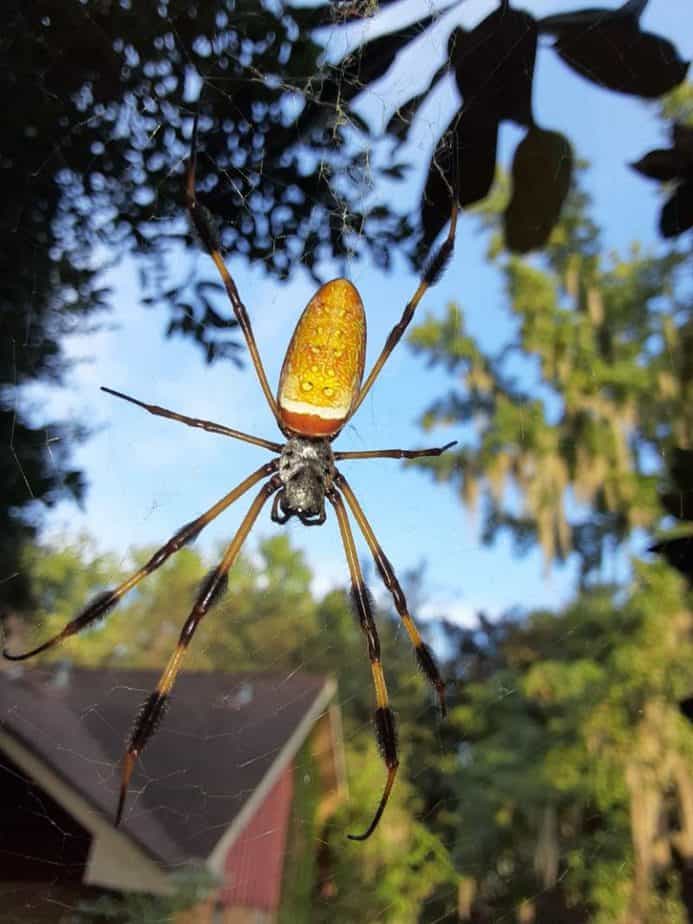
Size
The larger female banana spider reaches a size of 1 inch to 2 inches (25-50 mm). It is therefore one of the largest orb weaver spiders and one of the largest spiders in North America. Males are much smaller than females and are only around 0.2 inches (6 mm) long. Therefore, it is often hard to even spot a male.
Web
Like other orb weavers, the golden-silk orb weaver creates huge webs of up to 6 feet (2 meters) in diameter to catch flying insects. As soon as something hits the web, the golden orb weaver, waiting on the web, can feel the vibrations and can finish the prey off. Trichonephila clavipes creates a very strong silk that is eight times as strong as steel and is also being researched for medical purposes. Scientists hope to use the silk to repair broken human nerve strands.
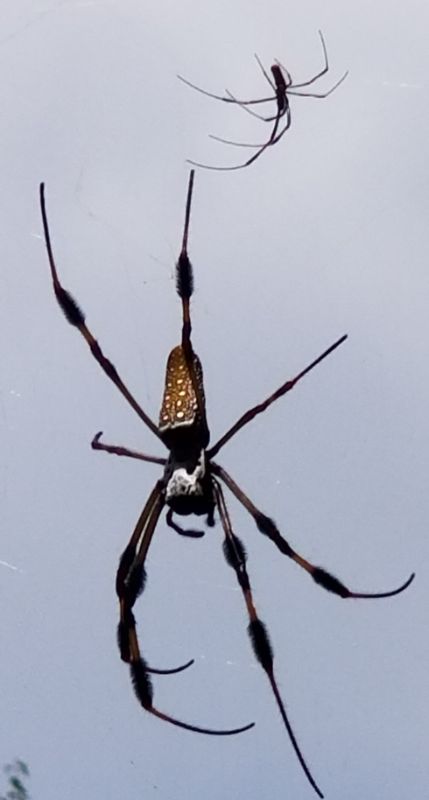
Bite
The banana spider is not a medically significant spider and a bite will most certainly only generate some minor discomfort. Generally much less than a bee sting. This is true for any orb weaver bite.
Trichonephila clavipes scientific classification
- Kingdom: Animalia
- Phylum: Arthropoda
- Subphylum: Chelicerata
- Class: Arachnida
- Order: Araneae
- Infraorder: Araneomorphae
- Family: Aranidae
- Genus: Trichonephila
- Species: Trichonephila clavipes
Other common names
Trichonephila clavipes is commonly also called banana spider, Golden-silk orb weaver, golden-silk spider, golden spider and golden orb weaver.
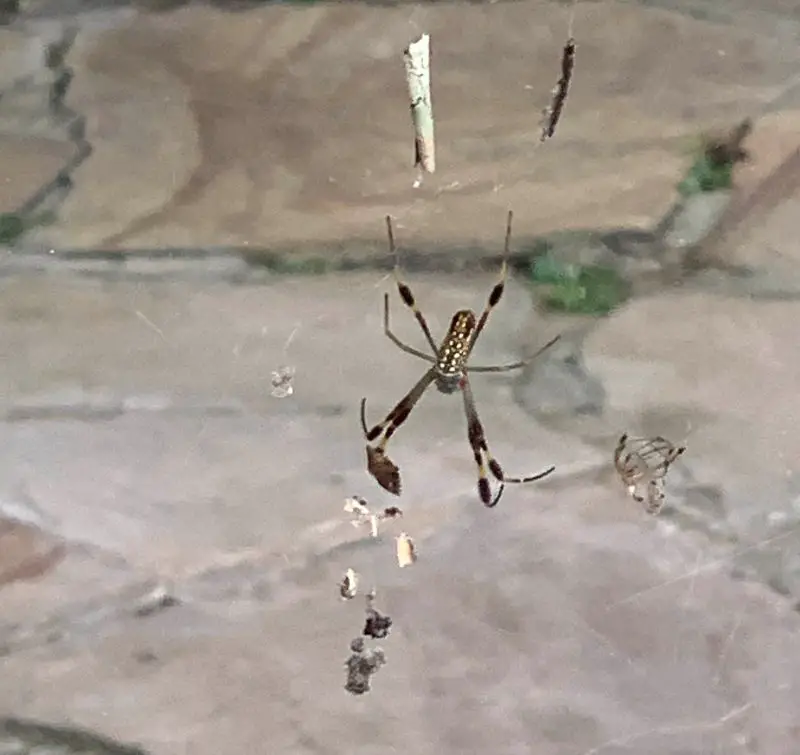
Distribution of the Golden Silk orb weaver in the USA
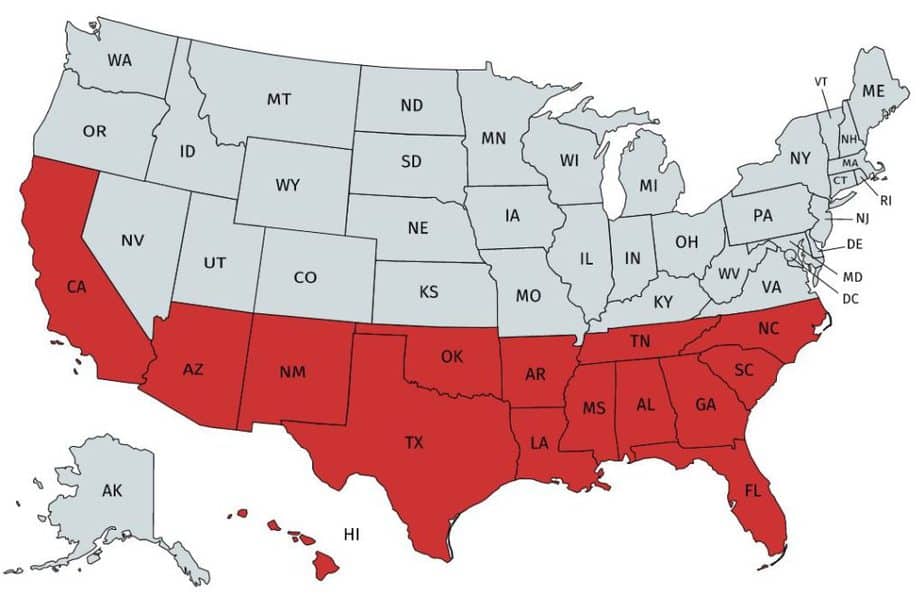
As mentioned above, the Golden Silk orb weaver can be found in the warm, Southern United States. That means that it can mostly be found in the following states: Alabama, Arizona, Arkansas, California, Florida, Georgia, Hawaii, Louisiana, Mississippi, New Mexico, North Carolina, Oklahoma, South Carolina, Tennessee and Texas. However, during the hotter summer months, some specimen may travel further North and reproduce also in other States.

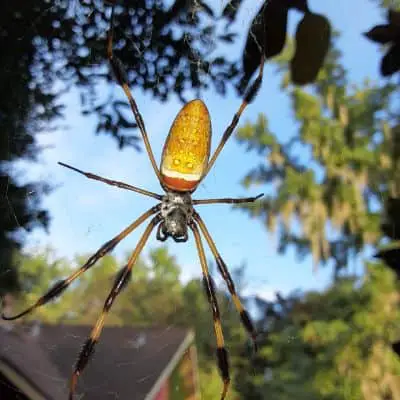
Found in Newberry, South Carolina. Body was “flattened” and oblong, legs thin with fuzz at the joint. Found on a web with random construction in a toolshed. Between 1-2 inches in diameter.
Hello Rigel,
This is a golden-silk orb weaver (Trichonephila clavipes) – also called banana spider:
https://usaspiders.com/trichonephila-clavipes-golden-silk-orb-weaver/
This spider is making a web outside our front door. It is disorganized connecting to the overhead light, door and wall. We thought it was a zipper spider, but it isn’t the right coloring with yellow. ID finder didn’t work for this one.
Hello Jeff, thanks for getting in touch! This is a banana spider or golden-silk orb weaver (Trichonephila sp.): https://usaspiders.com/trichonephila-clavipes-banana-spider/
A banana spider has made a web and as of last night, an egg sack on our porch. Could you tell me what to expect with the hatching, when to expect it? Will she die now? Would it be safe to relocate her and the sack? I want to avoid the hatching near my front door.
I found this guy a few days ago and idk if it’s poisonous or not it’s killed three big spiders in the past few days and I don’t want my dogs getting hurt if it’s a poisonous spider. It was found in the Lawrenceville area
Hello Jensen, thanks for uploading this shot! This is a banana spider (Trichonephila clavipes): https://usaspiders.com/trichonephila-clavipes-banana-spider/
It’s not a medically significant spider and this looks like a juvenile female – but it’s hard to tell for sure from this picture.
Markings don’t match yellow garden spider. Perhaps this one is low on food?
Hello Mike, this is a golden-silk orb weaver or banana spider, Trichonephila clavipes. It’s not a medically significant spider and occurs in the southern United States. Would you mind sharing your location where you found the spider?
Found this one in the wooded area along our lake in Central Florida. Banana Spider?
Thanks
Hello Tom, awesome shot! Yes, this is a banana spider (Trichonephila clavipes).
What we believe is a banana spider on our back door of SC
I found this pair of spiders in a wooded area beside my home in Shallotte, NC on 9-5-21. I believe they are a pair of “Banana Spiders” or Golden-Silk orb weaver spiders (Trichonephila Clavipes) per information on this site, but please confirm. If I’m correct, then the smaller one is the male and the very large one is the female. The larger on measured an almost unbelievable 2.5 to 3″ long.
Hello Stanley, thanks for getting in touch! Yes, you are right with your identification. These are male and female banana spiders (Trichonephila clavipes). The smaller one is the male.
Is this a banana spider. Saw several at a golf course near Auburn Alabama
We have this large spider outside our home. We have had them in the past, but never this large. We have nicknamed it Shelob. Its body is about 1″ long, and total diameter is about 3-3.5″ long. Have I correctly identified this as a banana spider?
I’m wondering if it isn’t an invasive Joro spider, a Asian native, perhaps immature?🤔
I am here to find the key features to tell the difference. Joros have red on abdomen in mature females, and don’t have the same dot pattern, but am less sure on telling immature ones from the darker variations of older Banana spiders…
Hello Jeff and N.V., yes, this is most likely a joro spider (Trichonephila clavata). The main differences to tell them apart are:
– Their range (in the U.S., joros are currently only found in Georgia and South Carolina)
– Banana spiders have a more banana-yellow color while joros are greenish-yellow
– The black leg bands of banana spiders have tufts of hair while joros usually don’t.
Found this in my yard in Picayune, MS! Web was at least 6 feet wide, and wrapped all the way up a very large tree, 2 adults, 3+ babys, about as big as my hand! 😱
Hello Kane, thanks for getting in touch! This beauty is a female banana spider (Trichonephila clavipes). It’s not medically significant. The three babies may be males which are a lot smaller than the females. https://usaspiders.com/trichonephila-clavipes-banana-spider/
What is this? Hopefully not a banana spider. Were in okla.
Hello Cassie, thanks for getting in touch! No, this is not a banana spider, it’s a black and yellow garden spider (Argiope aurantia). It’s not medically significant. It’s not medically significant:
https://usaspiders.com/argiope-aurantia-yellow-garden-spider/
Hi! I found this large spider on my back porch steps this morning in Edom, Texas (northeast Tx). Is it a banana spider? Thank you for your help identifying it.
Cassie
Hello Cassie, thanks for getting in touch! No, this is not a banana spider, it’s a black and yellow garden spider (Argiope aurantia). It’s not medically significant. It’s not medically significant:
https://usaspiders.com/argiope-aurantia-yellow-garden-spider/
Picture attached
Hello John, can you please share your location to help with the identification? This is a Trichonephila sp. golden orb-weaver. It almost looks like a joro spider (Trichonephila clavata), which has been recorded in Georgia. If you are not located anywhere near Georgia, this is a banana spider (Trichonephila clavipes): https://usaspiders.com/trichonephila-clavipes-banana-spider/
Above my brother’s driveway in Newnan. Took some finagling to get it’s picture but we’ll leave it be.
There are several of these in my front yard and although they look like a zigzag zag spider that I found out about, there is different patterns to this species.
Hello Rick, thanks for getting in touch! This is a banana spider, or golden-silk orbweaver (Trichonephila clavipes). It’s not a medically significant spider: https://usaspiders.com/trichonephila-clavipes-banana-spider/
Lots of big spiders here in FL. What is this lady?
Hello Charlotte, thanks for getting in touch! This is a banana spider (Trichonephila clavipes): https://usaspiders.com/trichonephila-clavipes-banana-spider/
My daughter saw this spider on the ceiling of my patio & the next day the spider had set up her orb web between my 12ft columns smack center of the patio. I told her it was a banana spider & not dangerous but she begs to differ. I’m going to watch her thrive. This is day 3, Oct. 1st.
Hello Angie, thanks for getting in touch! This is definitely a banana spider (Trichonephila clavipes)
Great site! Already identified several in the Tuscaloosa, Alabama area. Here are some pix.
Oops, apparently only one image at a time. Will send them separately.
It’s raining so no discernable web pattern. Hanging between bushes.
Hello Mark, this is a banana spider (Trichonephila clavipes): https://usaspiders.com/trichonephila-clavipes-banana-spider/
I have had the pleasure to be able to observe two golden silk orb weavers this summer and fall. Both fell from their Webb’s on a cold night three days ago. Both were alive but only moved when touched. Both are still alive but only respond when touched. Is this their normal behavior when they die or is it that the cold that is causing their death?
Found in hoschton, GA In November
Hi Natailia, this is a golden silk orb weaver (Trichonephila clavipes): https://usaspiders.com/trichonephila-clavipes-banana-spider/
They are a type of harmless orbweaver – great for insect control.
I’m terrified of spiders… but did well to get a picture of one. I can feel my skin crawling.
Found on a play set in Delray Beach, Florida. What am I?
-Lauren Lombardo
Hi Lauren, this is a banana spider (Trichonephila clavipes): https://usaspiders.com/trichonephila-clavipes-banana-spider/
Suddenly have an increase if spiders Can you identify.
Hi Steven, this is a golden silk orbweaver (Trichonephila clavipes): https://usaspiders.com/trichonephila-clavipes-banana-spider/
I believe this is a banana spider that made a web above my shed by the house in Conway, SC. She originally attached the web to my trash bin, so I made a deal that I would leave her be if she stayed away from the trash can. Three weeks later and the web has gotten larger—I think she has too—but hasn’t been attached to the trash bin.
Black with yellow
On the large side
Body Length 1 to 2 inch
Hi Michael, I assume you are located in Georgia or somewhere close to it. This is a joro spider (Trichonephila clavata), an introduced species and close relative of the banana spider: https://usaspiders.com/trichonephila-clavipes-banana-spider/
This remarkable spider was found in my backyard near Loganville, Georgia this afternoon. I think it must be a Joro spider but I’m not sure. The yellow bands on the top side seemed to be luminescent. The web was three dimensional which made it difficult to focus my iPhone camera on the spider.
Hello Greg, thanks for sharing this find! Yes, this is definitely a joro spider (Trichonephila clavata).
I believe this is a golden silk orb weaver (Banana Spider). We found it on our morning walk in Key West.
A picture of what I believe to be a banana spider eating a joro spider. I have several videos and pictures comparing the two
IMG_3963
Southeast, GA
This beautiful orb weaver and her mate made its home right outside the window of my home office. I enjoy looking up from my computer screens and watch them. I’ve been watching them thrive and grow since she showed up and much younger. I’ve been amazed at her routines and behavior. I’ve even caught her molting process. This photo was taken shortly after I threw a live palmetto bug at her web. She quickly wrapped it up and took it to the middle of her web to feed.